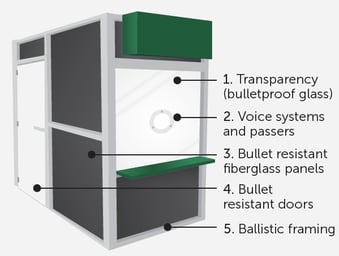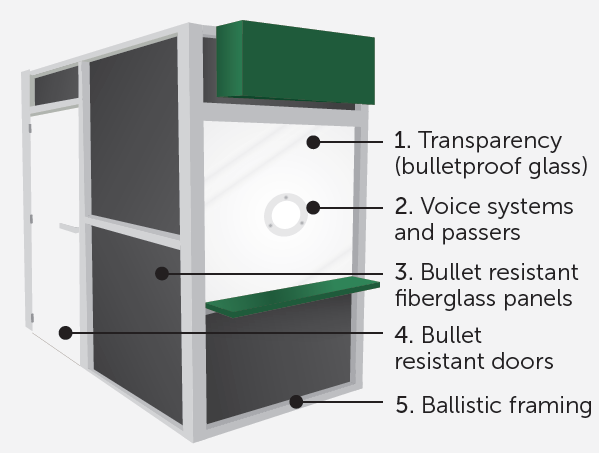Whether it’s an architect’s first time working with bulletproof glass, or their twenty-first time, they usually have questions about about which products best fit their clients’ needs.
When working on a design that requires a single protected area, we recommend the inclusion of a fixed bulletproof barrier system. Fixed barrier systems can be found in many different types of environments — from entertainment venues to banks and hospitals. Here’s a breakdown on this particular security feature.
Understanding the Fixed Bulletproof Barrier System
While specific fixed barrier configurations vary depending on the environment, standard elements of the system remain. If the design you’re working on requires security for a single transaction or ticket window as seen in convenience stores, bus stations, movie theaters, pawn shops, and stadiums, for example, then a fixed barrier system is an ideal option for you.
Components of a Fixed Bulletproof Barrier System
Bulletproof Glass
 Before you begin, you need to ask and answer the following questions:
Before you begin, you need to ask and answer the following questions:
- Will this glass be used on an interior or exterior application?
- What is the perceived threat level?
If you are using the glass for an exterior application, you’ll want to stay away from acrylic bulletproof glass, and instead choose polycarbonate or glass-clad polycarbonate (GCP).
While polycarbonate and GCP can resist attempted forced entry and harsh elements which give them an advantage over acrylic for extreme conditions, acrylic has the advantage when it comes to ease of manufacturing. This, as well as a lower price point, is why acrylic is ideal for most interior installations.
Bullet Resistant Framing and Doors
Many people assume that once they have installed bulletproof glass, they’re all set. What they don’t take into account is a situation where a gunman aims below the glass, or misses the glass and hits the frame. Total Security Solutions recommends reinforcing the barrier panels and counters with ballistic fiberglass as well as the glass with rated frames in order to ensure complete coverage. Finally, a truly secure barrier is not complete without ballistic doors and hardware.
When designing a barrier, security should be the ultimate concern, but you also can’t ignore the functionality of the space. The barrier should not keep the person behind it from doing their job. That means you need to consider the type of transaction that takes place at each barrier, and select communication features that don’t get in the way of customer service.
For example, if it’s a ticket window, all you’ll need is a currency tray to pass money and tickets back and forth. If the space is used for merchandise, as in the case of a convenience store or pharmacy where the employee needs to pass merchandise, you might need a deeper currency tray, a package passer, or pass-thru drawer. Another element to consider is a communication device. There are multiple options to choose from – both natural and electronic.
If you have additional questions about designing a freestanding barrier system, feel free to contact one of our design consultants.
Next Steps
- Understand more about bulletproof glass by downloading our infographic
- Check out our Architect Resource Center and download our Architect Information Kit
- Sign up for our newsletter to stay up to date with the latest architect news


